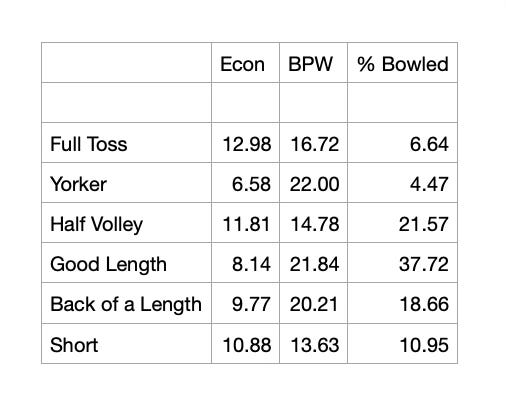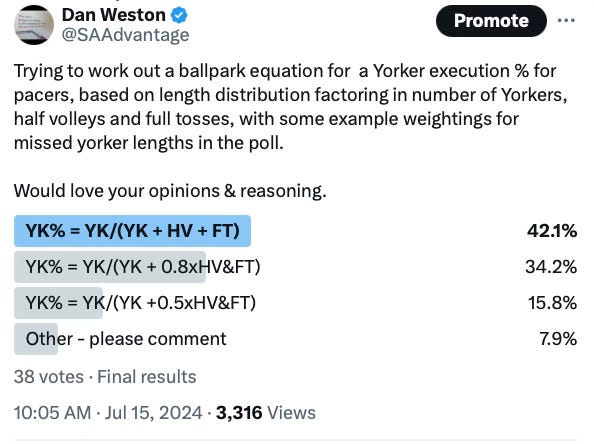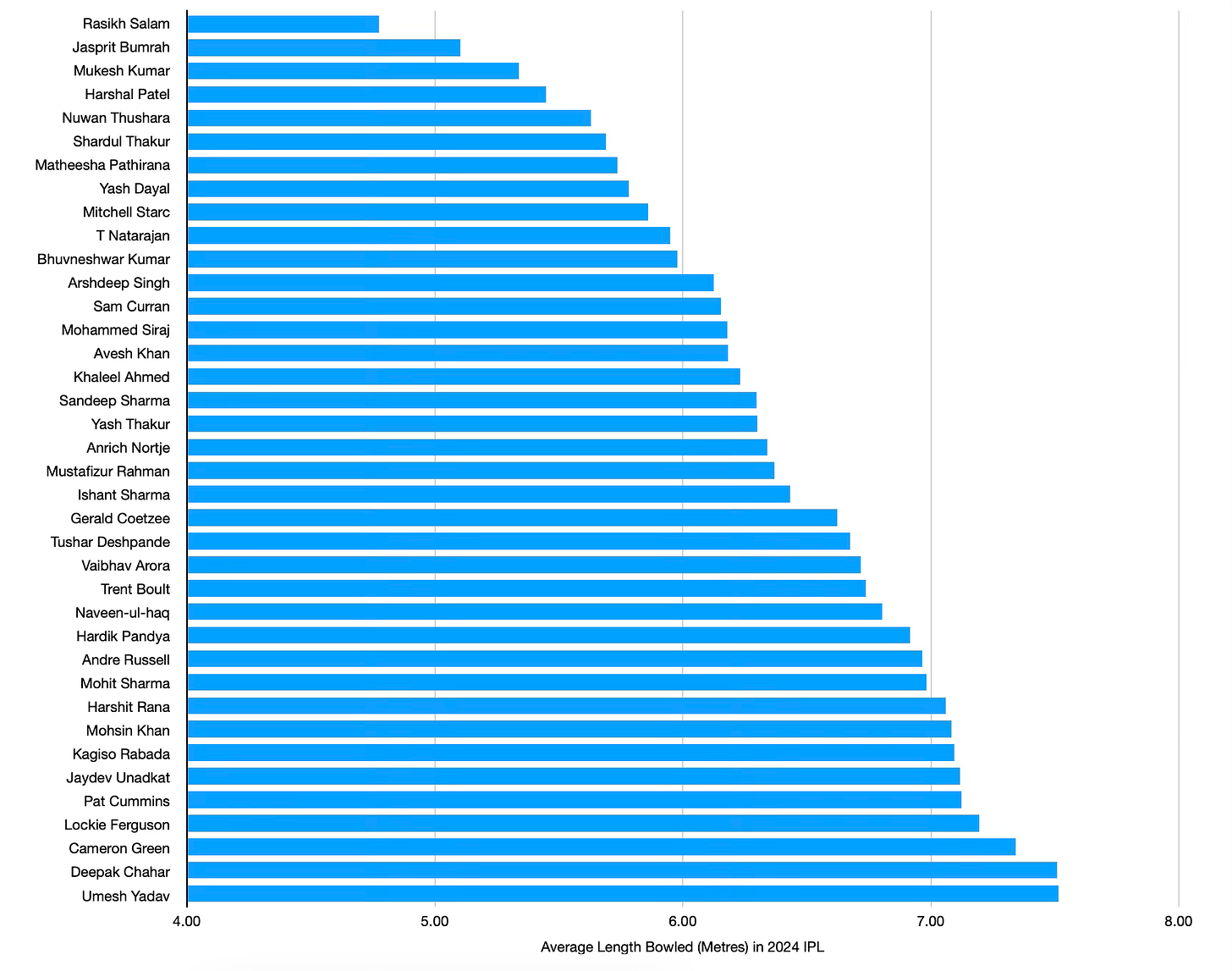IPL 2024 - The Trouble With Yorkers & Short Balls
Bowling plans are more complex than many think...
How many times have you watched a match and heard the commentators say things like ‘he’s got to bowl a Yorker here’, or ‘Yorker or short at the death, great options’?
But are they? Very little has been studied about challenging such assertions, particularly in the public domain, and the vast majority of bowling coaches I’ve worked with wouldn’t have much grasp on the information either (although one has worked with me intensively on pacer length distribution, to great effect for his teams).
Commentators, coaches and players often also say things like ‘bowl your best ball’, but actually what is a bowler’s best ball? Of course, it depends because what represents the best ball for bowlers varies depending on who they are, and often the game situation too, but has anyone actually established what the best ball for a bowler really is?
It’s generally accepted that a successful Yorker will be the most effective ball a pacer can bowl, and data would back that up - see further in this report. In the IPL 2024, only 17 pacers bowled 10 Yorkers or more in the tournament, with two players - Jasprit Bumrah and Avesh Khan miles ahead of the rest for successful Yorker execution.
Some readers might be thinking ‘well, just bowl Yorkers all day long, and life is easy’ but they’d be wrong. Because while Yorkers are usually the most effective ball, what happens when a bowler misses their length?
If a bowler misses the Yorker by length, they bowl either full tosses or half-volleys (slot) which both have very poor expectation generally for a bowler - see the economy and balls per wicket data shortly.
So even if a bowler can bowl, say, two successful Yorkers per match (and that’s a level only really Bumrah and Avesh can surpass) then they’re still at risk of bowling more bad balls which will generally get punished. Yorker execution percentages for pacers in IPL 2024 will be at the end of this piece.
Here’s a look at the economy and balls per wicket for the six main lengths for pacers in the 2024 IPL, plus the percentage that they were bowled:-
This backs up everything I’ve said. Yorkers have the best economy by around 1.5 runs per over compared to the next most economical length. However, if a bowler misses that Yorker length, full tosses (2.16 runs per ball) and half volleys (1.97 runs per ball) will be the outcome, and that’s a pretty bad outcome for the bowler.
It’s also interesting to see that pacers bowled almost 11% short balls. This is far too high, with bowlers looking at the extra short ball allowed this year as a target, as opposed to an option. I wrote about that phenomenon here. In fact, if a pacer’s speeds are below 83mph/133kph then they should generally be very sparing with their use of the short ball - it’s so ineffective at that speed or below unless it’s a deliberate slower ball.
The biggest margin for error is around the good length (6-8m) and back of a length zone (8-10m) - around 7-9m in pitching length. However, bowlers didn’t bowl a good length in this year’s IPL as much as is often the case in other leagues - in England, for example, it’s more around the 55% mark for balls bowled.
Of course, a bowler can’t be predictable and metagame clearly exists with certain batters and in certain game situations but it does show a basic zone for a stock ball for a bowler to formulate their length strategy. Then, they can deviate from that length in various circumstances, such as for deception or match-up purposes.
When trying to assess whether a bowler intended to bowl a specific length, the problem is that only the bowler knows their actual plans (they may, or may not be able to execute these plans). So, yesterday, on X/Twitter, I posted a poll asking for opinions on weightings for how to work out Yorker success percentage.
The poll didn’t get close to as many votes on this poll as I would usually get, probably due to the technical nature of it, but it did provide some valuable ‘wisdom of the crowd’ insight.
Using the weightings in the poll (both in the options and responses), the overall equation to ascertain the Yorker execution percentage is as follows:-
Yorker % = Yorkers/(Yorkers + 0.8391 * Half Volleys & Full Tosses)
A few people replied saying that full tosses should have a slightly higher weighting than half volleys, but in terms of the actual results, it makes very little difference. I’m pretty comfortable with using the same weighting for those two lengths.
Based on this, Yorkers are executed just 18.88% of the time, illustrating the pretty high variance of this bowling option. If we use these weightings to actual results in the IPL in 2024, we can estimate that a planned Yorker turns into a full toss 25% of the time, a Yorker 19% of the time and a half-volley 56% of the time.
Using these numbers as weightings towards economy rates and balls per wicket, we can then establish that a planned Yorker costs 11.11 per over and takes a wicket every 16.63 balls. Given this, planned Yorkers are quite a bit worse in terms of economy than good length balls, but do take wickets more frequently.
However, given that these planned Yorker numbers are similar to those for the short ball, it’s extremely questionable whether the reward from taking a wicket more frequently (around 5 balls per wicket gain) is worth the three runs per wicket trade off.
Of course, this isn’t to say that a Yorker shouldn’t be attempted, but like a short ball, should be part of a balanced strategy. Smart bowlers should be looking to use unique dynamics such as their pace and release height in order to assess their suitability to bowling Yorkers, plus also who they are bowling at and the match situation.
If a scenario where a bowling team needs to win and is defending two runs off the last ball (e.g. they win with a wicket) then a Yorker or a short ball is a great option, but if they are defending four plus off the last ball (e.g. they win if they don’t concede a boundary), there are lower variance lengths to bowl.
So, next time you listen to a commentator saying that a Yorker is the best option for the ball about to be bowled (or commonly, after-timing as soon as a boundary is hit asking why the bowler didn’t bowl a Yorker) then there’s a lot more to consider, such as the reasons above.
Before we finish, probably the data you’ve been waiting for - more specific bowler data including those bowlers who have the most successful Yorker execution percentages.
First of all, using the midpoints of each of the various length categories, here’s a chart showing the average length of the pacers bowling 100+ balls in IPL 2024:
Rasikh Salam, Jasprit Bumrah, Mukesh Kumar and Harshal Patel bowl fuller than the others, with the likes of Cameron Green, Deepak Chahar and Umesh Yadav noticeably shorter than the rest. Generally speaking, those with slightly shorter lengths have more of a defensive dynamic in terms of economy rates and balls per wicket figures than those who bowl fuller lengths.
Having this type of information would be extremely useful for teams. Firstly, batters can have a better idea of what to expect from each bowler (e.g. if a batter knows Deepak Chahar rarely bowls full tosses/yorkers then you can be much clearer on your options) while the teams who the bowlers play for can work towards optimal length distribution.
Finally, based on the weighted formulas used earlier, here’s the top six IPL pacers for Yorker execution percentage:
Certainly, Bumrah and Pathirana are renowned for their Yorker skills and that’s shown here, while Avesh Khan also rated well for actual Yorkers bowled too - his Yorker percentage in proportion with missed Yorker lengths was the best in the tournament.
Anyone interested in discussing how I can help their team with strategic management and data-driven analysis, or contribute to any media work, can get in touch at sportsanalyticsadvantage@gmail.com.
Raw data sourced from Kadamba/Cricket 21.







